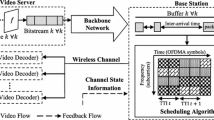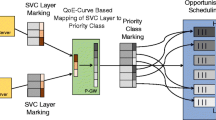Abstract
The ongoing development of mobile communication networks has led to an expressive growth in capacity demand, mainly due to video streaming services, which together with the Internet of Things sector represent a challenge for the mobile network operators. Video streaming is already responsible for most of the Internet traffic, and the real-time video calling services are becoming increasingly common. The use of strict quality of service parameters can lead to global resource starvation, where no user can be served with the resources available. In case of network congestion is important to prevent global resource starvation problem and also serve as many users as possible with a reasonable quality of service while still ensuring a minimum of connectivity to other users. Considering this problem, this article presents a new channel-aware downlink packet scheduler for Long Term Evolution networks that aims to increase the number of satisfied real-time video streaming users. The performance evaluation was done through computer simulations, using peak signal-to-noise ratio (PSNR) to compare the quality delivered by competing algorithms, and the number of users who are given enough resources to play video with quality. The results indicate that the proposed method outperforms the commonly-used algorithms considering the number of satisfied users and average video PSNR, mainly under moderate-to-heavy traffic load conditions.




Similar content being viewed by others
References
Cisco. (2015). 4G mobile broadband evolution: 3GPP release 11 and release 12 and beyond. In Technical report. Cisco Co., San Jose. Retrieved from http://www.cisco.com.
Nossenson, R. (2009). Long-term evolution network architecture. In IEEE international conference on microwaves antennas and electronics systems: Communications (pp. 1–4).
Capozzi, F., Piro, G., Grieco, L. A., Boggia, G., & Camarda, P. (2013). Downlink packet scheduling in LTE cellular networks: Key design issues and a survey. IEEE Communications Surveys Tutorials, 15(2), 678–700.
Monteiro, V. F., Sousa, D. A., Maciel, T. F., Lima, F. R. M., Rodrigues, E. B., & Cavalcanti, F. R. P. (2015). Radio resource allocation framework for quality of experience optimization in wireless networks. IEEE Network, 29(6), 33–39.
Sahoo, B. P. S., Puthal, D., Swain, S., & Mishra, S. (2015). A comparative analysis of packet scheduling schemes for multimedia services in LTE networks. In 2015 International conference on computational intelligence and networks (pp. 110–115).
Kumar, P., Kumar, S., & Dabas, C. (2016). Comparative analysis of downlink scheduling algorithms for a cell affected by interference in LTE network. Annals of Data Science, 3(2), 135–153.
Nsiri, B., Mallouki, N., Mhatli, S., Ghanbarisabagh, M., Ammar, M., & Hakimi, W. (2015). Modeling and performance evaluation of novel scheduling algorithm for downlink LTE cellular network. Wireless Personal Communications, 83(3), 2303–2316.
Ragaleux, A., Baey, S., & Fladenmuller, A. (2016). An efficient and generic downlink resource allocation procedure for pre-5G networks. Wireless Communications and Mobile Computing, 16(17), 3089–3103.
Liu, Q., & Chen, C. W. (2015). Smart downlink scheduling for multimedia streaming over LTE networks with hard handoff. IEEE Transactions on Circuits and Systems for Video Technology, 25(11), 1815–1829.
Asadollahi, F., & Dehdasht-Heydari, R. (2018). Introduction of a novel hybrid weighted exponential logarithm-maximum throughput (HWEL-MT) scheduler for QoS improvement of LTE/4G cellular networks. Wireless Personal Communications, 98(1), 91–104.
Tehrani, R. H., Vahid, S., Triantafyllopoulou, D., Lee, H., & Moessner, K. (2016). Licensed spectrum sharing schemes for mobile operators: A survey and outlook. IEEE Communications Surveys Tutorials, 18(4), 2591–2623.
Kolehmainen, N., Puttonen, J., Kela, P., Ristaniemi, T., Henttonen, T., & Moisio, M. (2008). Channel quality indication reporting schemes for UTRAN long term evolution downlink. In VTC Spring 2008-IEEE vehicular technology conference (pp. 2522–2526).
Dardouri, S., & Bouallegue, R. (2015). Comparative study of downlink packet scheduling for LTE networks. Wireless Personal Communications, 82(3), 1405–1418.
Bojovic, B., & Baldo, N. (2014). A new channel and QoS aware scheduler to enhance the capacity of voice over LTE systems. In 2014 IEEE 11th international multi-conference on systems, signals devices (SSD14) (pp. 1–6).
Yusof, A. S. M., Wee, K., Ang, E. M., & Abdullah, M. F. A. (2015). Performance study of channel-QoS aware scheduler in LTE downlink using NS3. In 7th International conference on emerging networks and systems intelligence (pp. 44–49).
Baldo, N., Miozzo, M., Requena-Esteso, M., & Nin-Guerrero, J. (2011). An open source product-oriented LTE network simulator based on NS-3. In Proceedings of the 14th ACM international conference on modeling, analysis and simulation of wireless and mobile systems (MSWiM) (pp. 293–298). New York, NY, USA.
3GPP, “TR36.814,” March 2010, further advancements for E-UTRA physical layer aspects, release 9, 3rd Generation Partnership Project.
Piro, G., Baldo, N., & Miozzo, M. (2011). An LTE module for the NS-3 network simulator. In Proceedings of the 4th international ICST conference on simulation tools and techniques. Series SIMUTools ’11. ICST, Brussels, Belgium, Belgium: ICST (Institute for Computer Sciences, Social-Informatics and Telecommunications Engineering) (pp. 415–422).
Erceg, V., Greenstein, L. J., Tjandra, S. Y., Parkoff, S. R., Gupta, A., Kulic, B., et al. (1999). An empirically based path loss model for wireless channels in suburban environments. IEEE Journal on Selected Areas in Communications, 17(7), 1205–1211.
DSL-Forum, “Triple-play services quality of experience (QoE) requirements,” (2006), TR-126.
Author information
Authors and Affiliations
Corresponding author
Additional information
Publisher's Note
Springer Nature remains neutral with regard to jurisdictional claims in published maps and institutional affiliations.
Rights and permissions
About this article
Cite this article
Pedroso, C.M., da Silva, C.A.G., Barbosa Junior, J.A. et al. A Low-Complexity Scheduler to Improve the Number of Satisfied Video Streaming Users in LTE. Wireless Pers Commun 109, 1121–1132 (2019). https://doi.org/10.1007/s11277-019-06606-5
Published:
Issue Date:
DOI: https://doi.org/10.1007/s11277-019-06606-5




